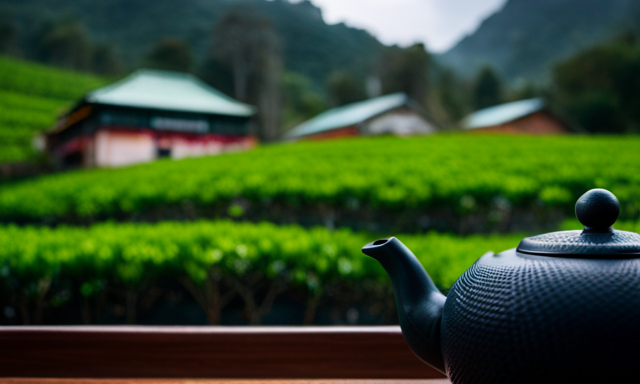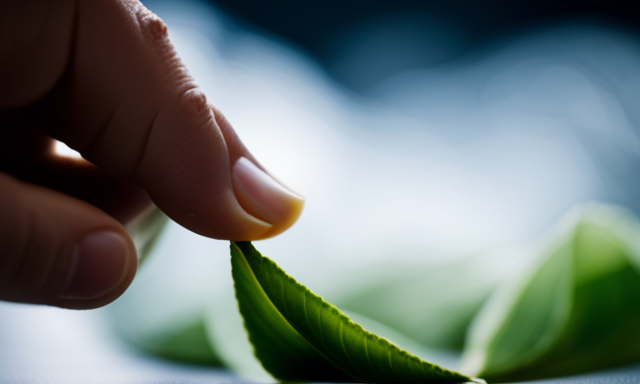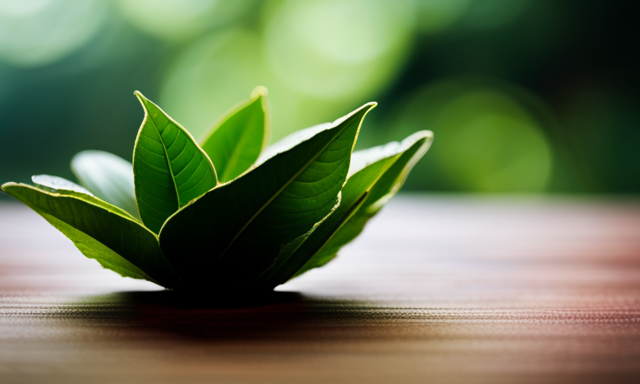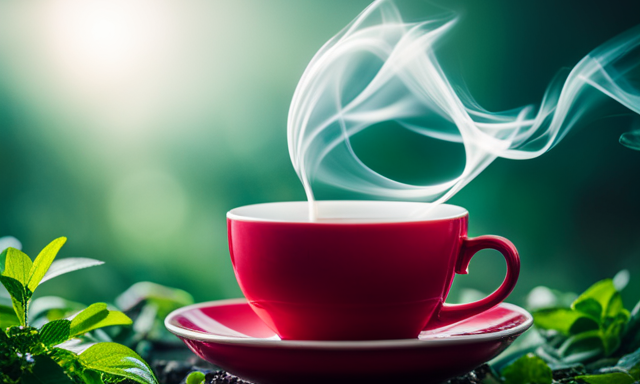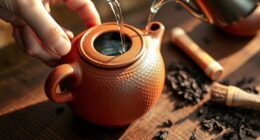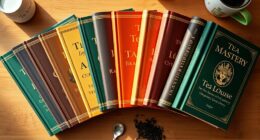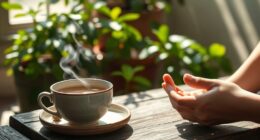Step into a world of warmth and comfort as you embark on a journey to create the perfect cup of oolong milk tea. Imagine the aromatic blend of the finest oolong tea leaves, delicately steeped and combined with frothed milk to create a heavenly beverage that will awaken your senses.
In this article, I will guide you through the process of making oolong milk tea, sharing my expertise and tips along the way. Whether you’re a tea connoisseur or simply curious about this delightful concoction, you’re in for a treat.
Join me as we explore the health benefits of oolong tea, select the best tea leaves, and prepare our equipment for the ultimate tea-making experience.
Get ready to indulge in the soothing flavors and creamy goodness of oolong milk tea – a beverage that will transport you to a place of pure bliss.
Key Takeaways
- Savoring oolong milk tea can lead to lower stress levels and higher overall satisfaction, as supported by a study.
- Oolong milk tea can be served hot or chilled, and can be enhanced with toppings like cinnamon or cocoa powder.
- Customize oolong milk tea by experimenting with sweeteners, toppings, and finding your preferred level of sweetness.
- Explore different tea brands to discover the unique flavor profiles and find your favorite.
Overview of Oolong Tea and its Health Benefits
Oolong tea is a type of traditional Chinese tea that offers a wide range of health benefits. There are various oolong tea varieties available, each with its own unique flavor profile and brewing techniques. Some popular varieties include Tie Guan Yin, Da Hong Pao, and Oriental Beauty.
Brewing oolong tea correctly is essential to bring out its full flavors. The leaves should be steeped in hot water for around 3-5 minutes, depending on the desired strength. The water temperature should be around 190-200°F to avoid overcooking the leaves.
Once brewed, the tea can be enjoyed on its own or with a splash of milk for a creamy and comforting experience.
Now, let’s move on to choosing the right oolong tea leaves for your milk tea recipe.
Choose the Right Oolong Tea Leaves
When seeking the perfect leaves, you’ll dance through a verdant garden of possibilities, sifting through the emerald tapestry to find the one that whispers its secrets to your soul. Exploring different oolong tea flavors is an enchanting journey that leads to discovering your personal preference. From delicate and floral to robust and nutty, each flavor profile offers a unique experience. To embark on this adventure, I recommend visiting local tea shops that offer a wide selection of oolong tea leaves. These shops often have knowledgeable staff who can guide you in choosing the right leaves based on your taste preferences. Additionally, they may offer samples for you to try before making your final decision. Once you have found your perfect oolong tea leaves, it’s time to prepare your tea equipment and dive into the art of making oolong milk tea.
Prepare Your Tea Equipment
To prepare your tea equipment, start by selecting a teapot that allows the tea leaves to unfurl and release their flavors fully. A ceramic or glass teapot works best for oolong milk tea. Additionally, invest in a milk frother to achieve that creamy texture that makes this beverage so delightful. A handheld frother or a milk steamer will do the job perfectly. By having these tools on hand, you’ll be able to create a rich and velvety oolong milk tea that will satisfy your cravings.
Now, let’s move on to the next step and learn how to boil water to the optimal temperature for brewing.
Boil Water to the Optimal Temperature
Get ready to unleash the boiling fury of water to reach the ultimate temperature for oolong milk tea perfection.
Boiling water is a crucial step in making oolong milk tea, and mastering the art of water temperature control is essential for achieving the best flavor.
When boiling water for oolong milk tea, it’s important to use fresh, filtered water to enhance the taste. To ensure the optimal temperature, bring the water to a rolling boil and then let it cool for a few seconds. This will help reach the ideal temperature range of 190-205°F (88-96°C), which brings out the delicate flavors of oolong tea.
Once the water is at the perfect temperature, you can move on to the next step of steeping the oolong tea leaves, allowing their natural flavors to infuse into the water.
Steep the Oolong Tea Leaves
Once the water has reached the optimal temperature, it’s time to steep the oolong tea leaves and unlock their rich and complex flavors. Steeping is a crucial step in the process of making oolong milk tea, as it allows the tea leaves to infuse the hot water with their unique characteristics.
To achieve the perfect cup of oolong milk tea, follow these steps:
-
Measure the desired amount of oolong tea leaves. The general rule of thumb is 1 teaspoon of tea leaves per cup of water, but you can adjust according to your taste preference.
-
Place the tea leaves in a tea infuser or a teapot with a built-in strainer.
-
Pour the hot water over the tea leaves and let them steep for 3-5 minutes. This steeping time can vary depending on the type of oolong tea you’re using and your personal preference for strength.
-
After the desired infusion time, remove the tea leaves or strain the tea to separate the leaves from the liquid.
Now that the oolong tea leaves have been steeped to perfection, let’s move on to the next step of heating and frothing the milk for the ultimate oolong milk tea experience.
Heat and Froth the Milk
Now comes the fun part – heating and frothing the creamy goodness to complement the bold flavors of the steeped oolong leaves. To achieve the perfect consistency, it’s crucial to choose the right heating method and master the art of milk frothing techniques. The heating method you choose can greatly impact the taste and texture of your oolong milk tea. Some popular options include using a stovetop, microwave, or electric kettle. Experiment with different methods to find what works best for you. As for milk frothing techniques, you can use a handheld frother, a whisk, or even a blender to create that luxurious foam. The frothing process enhances the overall experience of the tea, adding a velvety touch to each sip. Once you’ve heated and frothed your milk to perfection, it’s time to combine it with the steeped tea, creating a harmonious blend of flavors and textures.
Combine the Steeped Tea and Frothed Milk
To achieve the perfect balance of flavors and textures, it’s time to blend the steeped tea and frothed milk together. The temperature of the steeped tea is crucial for achieving the best results. It should be hot but not boiling, as boiling water can scorch the delicate flavors of the tea. I recommend letting the steeped tea cool for a minute or two before combining it with the frothed milk.
When it comes to milk options, there are several choices to consider. Whole milk provides a creamy and rich texture, while almond milk offers a nutty and slightly sweet taste. For a lighter option, you can use skim milk, but keep in mind that it might result in a less creamy texture. Ultimately, the choice of milk depends on your personal preference and dietary restrictions.
Now that the steeped tea is at the right temperature and the milk is frothed to perfection, it’s time to combine them. Gently pour the frothed milk into the steeped tea, stirring slowly to ensure even distribution. This will create a velvety, creamy texture that complements the robust flavors of the tea.
Transitioning into the next section about adding sweeteners or flavorings (optional), you can enhance your oolong milk tea with a touch of sweetness or additional flavors.
Add Sweeteners or Flavorings (Optional)
Enhance your delicious blend by adding your choice of sweeteners or flavorings to elevate the taste experience.
When it comes to sweeteners, there are plenty of alternatives to choose from. You can opt for traditional options like sugar or honey, or explore healthier alternatives like stevia or agave syrup. These sweeteners will add a touch of sweetness to your oolong milk tea, balancing out the robust flavors of the tea itself.
If you prefer a flavored milk option, consider adding a splash of vanilla extract or a drizzle of caramel syrup. These additions will not only add a hint of flavor but also create a delightful aroma.
With a variety of sweetener alternatives and flavored milk options at your disposal, you can customize your oolong milk tea to suit your taste preferences.
Now it’s time to serve and enjoy the delightful concoction you’ve created!
Serve and Enjoy!
Once you’ve perfected your blend, it’s time to indulge in the satisfying experience of savoring a cup of this exquisite concoction – a treat that will leave you feeling blissful and content. Did you know that a study found that people who take the time to savor their tea and enjoy the moment have lower stress levels and higher overall satisfaction? So take a deep breath, savor each sip, and let the warmth of the cup envelop you in a moment of pure relaxation.
- Serving Suggestions:
- Serve your oolong milk tea hot or chilled, depending on your preference.
- For an added touch, sprinkle some cinnamon or cocoa powder on top.
- Pair your tea with a light and flaky pastry or a slice of fruit tart for a delightful combination of flavors.
Now that you know how to serve and enjoy your oolong milk tea, let’s explore some tips and variations for customizing your experience to suit your taste preferences.
Tips and Variations for Customizing Your Oolong Milk Tea Experience
Now that you know how to serve and enjoy your oolong milk tea, let’s dive into some tips and variations to elevate your tea-drinking experience. Customizing flavors is a great way to add a personal touch to your oolong milk tea. You can experiment with different types of sweeteners, such as honey or flavored syrups, to find the perfect level of sweetness. Additionally, don’t be afraid to get creative with toppings! Boba pearls, grass jelly, or even fresh fruit can add texture and depth to your drink. Another exciting aspect of oolong milk tea is trying different tea brands. Each brand has its own unique flavor profile, so don’t hesitate to explore and discover your favorite. Remember, the key to a truly enjoyable oolong milk tea experience is to have fun and embrace your own preferences.
| Tips for Customizing Your Oolong Milk Tea | Experience the Flavorful World of Tea Brands |
|---|---|
| Experiment with different sweeteners | Try a variety of tea brands |
| Add toppings like boba pearls or fresh fruit | Discover unique flavor profiles |
| Find your perfect level of sweetness | Embrace the diversity of oolong milk tea |
Frequently Asked Questions
What are the different health benefits of oolong tea compared to other types of tea?
Oolong tea offers a unique range of flavors compared to other types of tea. Additionally, studies suggest that oolong tea may aid in weight loss by boosting metabolism and reducing fat absorption.
Can I use any type of oolong tea leaves to make oolong milk tea?
To make oolong milk tea, it is recommended to use loose leaf oolong tea for a more authentic flavor. Steeping time is crucial as it affects the strength and taste of the tea.
Is it necessary to use a specific type of tea equipment to make oolong milk tea?
Using the right tea equipment is crucial for making oolong milk tea. It ensures proper brewing and extraction of flavors. Additionally, using high quality oolong tea leaves enhances the taste and aroma of the final beverage.
What is the optimal temperature to boil water for steeping oolong tea leaves?
The optimal water temperature for steeping oolong tea leaves is around 185-205°F. To achieve the perfect temperature, use a thermometer or bring the water to a boil and let it cool for a few minutes. The water temperature affects the flavor of oolong tea, with higher temperatures bringing out more bold and robust flavors.
Are there any alternative methods to froth the milk for oolong milk tea?
There are several alternative frothing methods for milk, such as using a French press or a handheld milk frother. These frothing milk techniques can create creamy and frothy milk, perfect for adding to oolong milk tea.
Conclusion
In conclusion, making oolong milk tea is a simple and enjoyable process that can be customized to suit your taste preferences. By choosing the right oolong tea leaves, preparing your equipment correctly, and steeping the tea leaves properly, you can create a delicious and refreshing beverage.
Whether you prefer it plain or with added sweeteners or flavorings, oolong milk tea is a versatile drink that can be enjoyed at any time of the day. So why wait? Start brewing your own oolong milk tea and savor the delightful flavors today.



